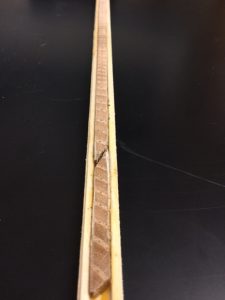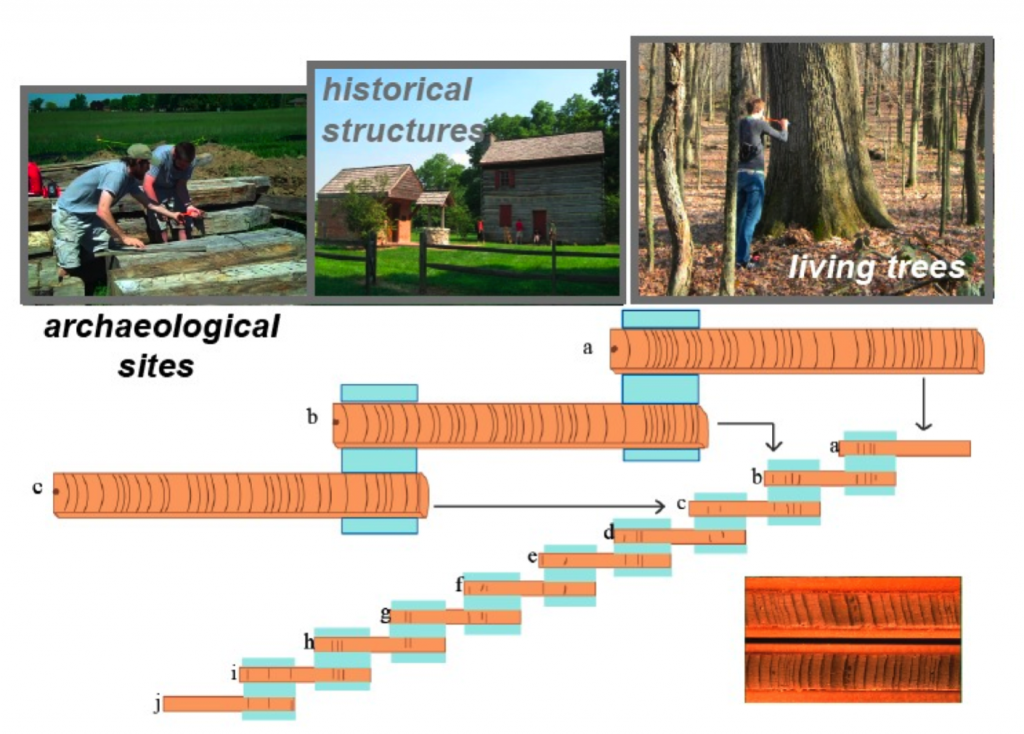Research at the Tree Ring Lab uses the process of dendrochronology, or tree ring dating. This process depends on the fact that certain living trees grow every year in a predictable way. When the tree is cored from the center of the trunk to the outside of its bark, this growth can be seen through annual growth rings. These rings can then be counted, and their widths compared to widths of rings from other measured trees, to date the tree.
Dendrochronology is also dependent upon the principle that tree growth is limited by key factors in the environment, such as precipitation and temperature. For climate research, this means that tree ring growth can be used to reconstruct these variables over time. For dating historical structures, this means that a given calendar year, trees in a given region will have similar amounts of growth. The calendar year can then, in principle, be dated based on the correlation of one core’s relative tree ring measurements to another tree. In reality, though, the tree ring measurements usually have to be normalized to remove noise, or growth changes caused by variables other than the ones being tested. Because a tree’s growth in one year also impacts its growth in another year — or each year’s growth is autocorrelated to itself — autoregressive models are also usually used to remove this autocorrelation and make the correlations used in our research statistically sound.
History
Dendrochronology was first used to date ancient Native American pueblos in the southwestern United States. Astronomer Andrew E. Douglass developed the modern technique of dendrochronology dating the wood in these structures (Douglass 1921, 1929) in an attempt to reconstruct sunspot variability over time. The methods first developed by Douglass have evolved and been employed throughout North America, Europe, and much of the temperate forest zones around the world (Baillie, 1982, 1995).

Coring
To get the core we use in our research, we first have to use what is known as an incremental borer. It’s essentially a hand-operated drill that captures a cylindrical tree core as it is screwed in and out of the tree. When coring, we’re sure to choose a place on the tree that seems healthy and will reach the center of the tree’s interior so that we can receive growth rings that are reflective of the tree’s growth during its entire lifespan.
We then take the cores to our lab and prepare them for measurement. If the cores were not glued onto a mount in the field, we do this in the lab. We then sand the cylindrical cores until they take on the flat-top shape you see in the first picture. The cores are then finely sanded to make each ring more visible. After the sanding, the cores are ready to be measured in the lab under a microscope.
Measurement
Ring width
To measure the cores’ ring width, we use Nikon microscopes and Velmex measuring systems. Crosshairs in the microscope viewers allow us to measure the width of each tree ring to the hundredth millimeter (.01 accuracy), which is the number of digits the programs we statistically analyze our data with use. We compile these measurements into columns in a .txt document for this analysis.
Blue Intensity (BI)
Another property of the wood that can be measured is blue intensity, or BI. Blue intensity is the amount of blue light emitted from a core when scanned, a property related to the wood’s density. While it’s a relatively new technique, it can sometimes have more significant correlations with climate variables than ring width. Learn more about blue intensity.
Dating and correlation
With the .txt document and data, we use a variety of computer programs from the Dendrochronology Program Library of the University of Arizona to correlate and date the tree rings. The first of these is COFECHA, which standardizes and normalizes the core and can correlate a single core’s ring widths to a master chronology (Holmes, 1983). If the master chronology was previously dated, the ring widths can be matched to the corresponding years based on how well they correlate. COFECHA gives us many possible correlations between the tree ring core and the master chronology, but the best samples usually have consistent and statistically significant levels of correlation, which leads to a clear calendar date.

More work can be done in programs like ARSTAN ( for “autoregressive standardization”), which can be used to plot and transform data. EDRM — a program for data adjustments — can also shift the dates in the data easily once we have discovered a tree ring date that correlates significantly with the master chronology. For BI measurements, we make use of CooRecorder — a program for measuring the amount of blue light in scans of cores.
References cited
- Baillie, M.G.L. 1982, Tree-Ring Dating and Archaeology. Croom Helm, London and Canberra. 274 pp.
- Baillie, M.G.L. 1995, A Slice Through Time: Dendrochronology and Precision Dating.B.T. Batsford, Ltd., London
- Douglass, A.E. 1921, Dating our prehistoric ruins: how growth rings in trees aid in the establishing the relative ages of the ruined pueblos of the southwest. Natural History 21(1), 27-30
- Douglass, A.E. 1929, The secret of the southwest solved by talkative tree-rings. National Geographic Magazine 56(6), 736-770.
- Holmes, R. L. 1983., Computer-assisted quality control in tree-ring dating and measurement. Tree Ring Bulletin, (1), 69-78.
